The Wearable Gaming Technology Market is estimated to be valued at USD 29.4 billion in 2025 and is projected to reach USD 115.0 billion by 2035, registering a compound annual growth rate (CAGR) of 14.6% over the forecast period.
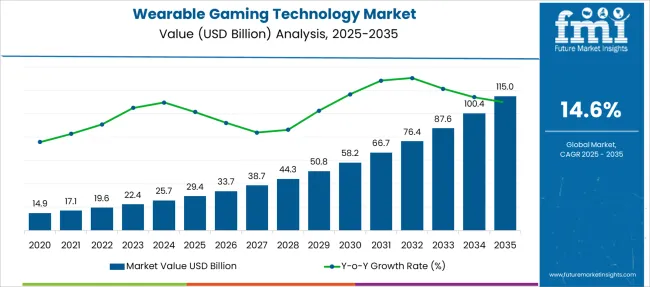
| Metric | Value |
|---|---|
| Wearable Gaming Technology Market Estimated Value in (2025 E) | USD 29.4 billion |
| Wearable Gaming Technology Market Forecast Value in (2035 F) | USD 115.0 billion |
| Forecast CAGR (2025 to 2035) | 14.6% |
The wearable gaming technology market is experiencing rapid expansion fueled by advances in virtual reality and augmented reality technologies. The increased integration of immersive gaming experiences in commercial entertainment venues has contributed significantly to market growth. Developers and technology providers have focused on enhancing user interaction and comfort, making wearable devices more appealing to a broad audience.
The rising popularity of individual gaming, driven by the convenience and engagement offered by wearable technology, is further expanding the user base. Moreover, the convergence of gaming with social and fitness applications has broadened the scope of wearable gaming devices.
Consumer demand for innovative and interactive gaming formats continues to grow, supported by improvements in hardware and software capabilities. Moving forward, growth is expected to be driven by VR and AR technologies, widespread commercial application, and a strong individual user presence.
The market is segmented by Type, Application, and User Type and region. By Type, the market is divided into VR and AR, Connected Wearables, Motion Sensing Technology Including Wearable 3D, Head Mounted Display, Serious Gaming, and Gamification. In terms of Application, the market is classified into Commercial and Household. Based on User Type, the market is segmented into Individual and Commercial. Regionally, the market is classified into North America, Latin America, Western Europe, Eastern Europe, Balkan & Baltic Countries, Russia & Belarus, Central Asia, East Asia, South Asia & Pacific, and the Middle East & Africa.
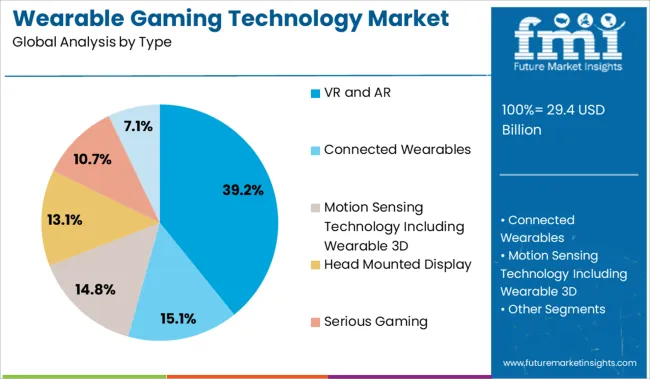
The VR and AR segment is projected to account for 39.2% of the wearable gaming technology market revenue in 2025, maintaining its lead as the preferred technology type. This segment’s growth is driven by the immersive and interactive nature of virtual and augmented reality gaming, which offers users a more engaging experience. The ability to blend real-world environments with digital content has made these technologies highly attractive to gamers and developers alike.
Wearable devices supporting VR and AR have become more accessible and user-friendly, enabling wider adoption. Advancements in motion tracking, display resolution, and latency reduction have enhanced the overall gaming experience.
As demand for realistic and social gaming environments grows, VR and AR wearables are expected to continue dominating the market.
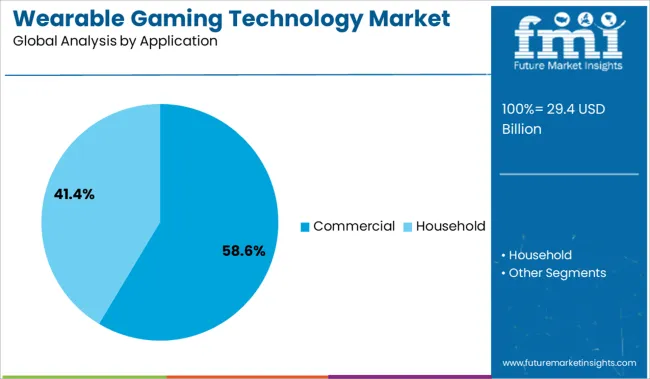
The commercial application segment is expected to contribute 58.6% of the market revenue in 2025, reflecting its status as the leading use case. Growth in this segment is propelled by entertainment centers, arcades, and theme parks investing heavily in wearable gaming technology to offer cutting-edge experiences. These venues utilize wearable devices to attract visitors seeking immersive and novel gaming formats.
The commercial sector benefits from the ability to provide multi-user interactive sessions and generate significant revenue from repeat customers. Moreover, corporate training and simulation applications that leverage wearable gaming technology have begun gaining traction, expanding the commercial market further.
Continued innovation and investment in commercial VR and AR setups are anticipated to sustain this segment’s growth.
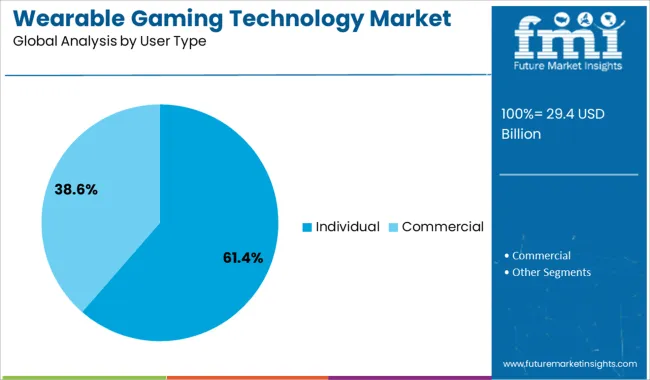
The individual user segment is projected to hold 61.4% of the wearable gaming technology market revenue in 2025, making it the largest user group. This segment’s expansion is fueled by increasing consumer interest in personal entertainment and interactive gaming options. Wearable devices have become more affordable and accessible, enabling gamers to enjoy immersive experiences from their homes.
Social gaming features and connectivity with online platforms have enhanced user engagement, encouraging community interaction and competition.
Additionally, advancements in wireless technology and device ergonomics have improved user comfort, supporting longer play sessions. The individual segment is expected to maintain its lead as gaming continues to evolve into a more personal and immersive experience driven by wearable technologies.
Global wearable gaming technology has significant potential. Technology advancements and innovation in wearable gaming devices drive the wearable gaming technology market. The rising popularity of series games and virtual reality-based games is fuelling the growth of the wearable gaming technology market.
Additionally, the rise in internet penetration allows gaming companies to deploy their gaming software in the cloud, enabling users with gaming accessories to access their games from anywhere.
Enterprises of large size and start-ups are investing in the wearable gaming technology market, which is helping the market to grow exponentially. Using wearable gaming technology allows gamers to enjoy virtual worlds while moving their bodies in the real world, increasing their physical activity. As digitalization continues to grow, virtual reality has gained momentum in the gaming industry to allow developers and manufacturers to maximize profits and significantly improve customer experiences.
Many large-scale game development companies are leveraging virtual reality to enhance user experiences and drive business value. Rising demand for online video gaming is expected to drive the growth of the wearable gaming technology market.
Piracy is one of the challenges faced by the global wearable gaming technology market. Moreover, the cost associated with the development of gaming wearable devices and software is also high. This makes them available only to a small segment of customers and is thus expected to hamper global wearable gaming technology market growth to some extent during the forecast period.
The high growth potential of the wearable gaming technology market is expected to immerge as virtual reality games can be played on different computing devices including specialized game consoles, standalone systems, advanced laptops and PCs. This is further opening up opportunities for market players to develop more advanced VR headsets to provide gamers with a more immersive experience.
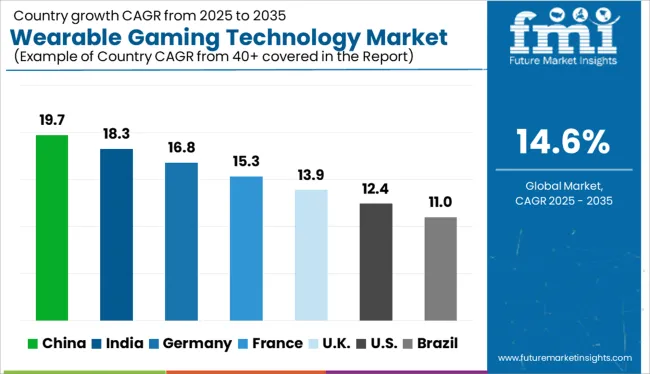
Geographically, the global market for wearable gaming technology is classified into regions namely, North America, Latin America, Western Europe, Eastern Europe, Asia-Pacific, Japan, Middle East and Africa.
The North American region is predicted to hold the largest market for wearable gaming technology. Due to the increasing adoption of advanced wearable gaming accessories, the growing demand for head-mounted displays, cloud computing, gesture tracking devices, and the robust presence of VR-based start-ups, North America is expected to generate the largest revenue share over the forecast period.
North America is estimated to hold a significant share of 30.5% of the wearable gaming technology market witnessing the highest growth. It is expected to take a greater share in the forecast period due to the rising focus on developing haptic-enabled wearables.
Furthermore, growth in the number of gaming hubs and increasing investment to develop advanced wearable gaming accessories are expected to drive the revenue of the North American wearable gaming technology market.
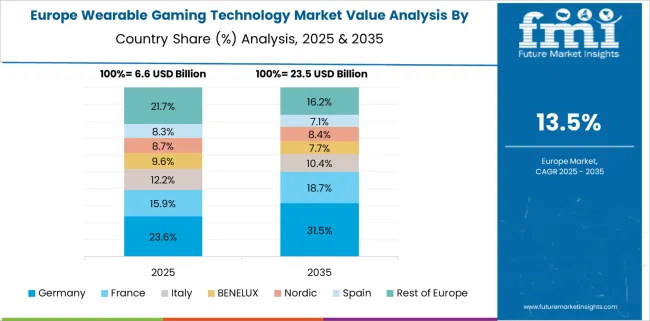
The Europe wearable gaming technology market has a global market share accounting for 21.6%. The region is expected to increase its share during the forecast period as they are fast in the adoption of technology.
A recent boom in the gaming industry has created value-grabbing opportunities for stakeholders in Europe's wearable gaming technology market. Augmented reality (AR) headsets and heart rate monitors are enabling manufacturers to unlock new revenue streams in the gaming industry.
The Asia Pacific region offers lucrative opportunities for key players in the wearable gaming technology market as the region is expected to register the highest growth in terms of revenue during the forecast period.
The rising popularity of casual and hyper-casual games, increasing internet penetration and the increase in the number of smartphone users will be boosting the demand for wearable gaming technology.
The wearable gaming technology market is very vast and competitive. In terms of share, a few of the key players dominate the market and will continue to dominate for the next decade.
Major companies profiled in the wearable gaming technology market include ICAROS GmbH, Cyberith GmbH, Zero Latency PTY LTD, Avegant Corp, HTC Corporation, Microsoft Corporation, ASUSTeK Computer Inc., Sony Corp, Razer Inc., and Teslasuit.

| Report Attribute | Details |
|---|---|
| Growth Rate | CAGR of 14.6% from 2025 to 2035 |
| Base Year for Estimation | 2025 |
| Historical Data | 2020 to 2024 |
| Forecast Period | 2025 to 2035 |
| Quantitative Units | Revenue in USD Million and CAGR from 2025 to 2035 |
| Report Coverage | Revenue Forecast, Volume Forecast, Company Ranking, Competitive Landscape, Growth Factors, Trends and Pricing Analysis |
| Segments Covered | Device Type, Distribution, Age Group & Region - Forecast till 2035 |
| Countries Covered | North America; Europe; APEJ; The Latin America; MEA |
| Key Companies Profiled | ICAROS GmbH; Cyberith GmbH; Zero Latency PTY LTD; Avegant Corp; HTC Corporation; Microsoft Corporation; ASUSTeK Computer Inc.; Sony Corp; Razer Inc.; Teslasuit; Others |
| Customization | Available Upon Request |
The global wearable gaming technology market is estimated to be valued at USD 29.4 billion in 2025.
The market size for the wearable gaming technology market is projected to reach USD 115.0 billion by 2035.
The wearable gaming technology market is expected to grow at a 14.6% CAGR between 2025 and 2035.
The key product types in wearable gaming technology market are vr and ar, connected wearables, motion sensing technology including wearable 3d, head mounted display, serious gaming and gamification.
In terms of application, commercial segment to command 58.6% share in the wearable gaming technology market in 2025.






Full Research Suite comprises of:
Market outlook & trends analysis
Interviews & case studies
Strategic recommendations
Vendor profiles & capabilities analysis
5-year forecasts
8 regions and 60+ country-level data splits
Market segment data splits
12 months of continuous data updates
DELIVERED AS:
PDF EXCEL ONLINE
Wearable Industrial Exoskeleton Devices Market Size and Share Forecast Outlook 2025 to 2035
Wearable Healthcare Devices Market Size and Share Forecast Outlook 2025 to 2035
Wearable Sensor Market Size and Share Forecast Outlook 2025 to 2035
Wearable Sleep Tracker Market Forecast and Outlook 2025 to 2035
Wearable Medical Device Market Size and Share Forecast Outlook 2025 to 2035
Wearable Injectors Market Size and Share Forecast Outlook 2025 to 2035
Wearable Defibrillator Patch Market Analysis - Size, Share, and Forecast Outlook 2025 to 2035
Wearable Fitness Tracker Market Size and Share Forecast Outlook 2025 to 2035
Wearable Translator Market Size and Share Forecast Outlook 2025 to 2035
Wearable Cardioverter Defibrillator Market Size and Share Forecast Outlook 2025 to 2035
Wearable Electronics Market Size and Share Forecast Outlook 2025 to 2035
Wearable Band Market Size and Share Forecast Outlook 2025 to 2035
Wearable Beauty Market Size, Growth, and Forecast for 2025 to 2035
Wearable Medical Robots Market - Trends & Forecast 2025 to 2035
Wearable Computing Market Trends – Growth & Forecast 2025 to 2035
Wearable Blood Pressure Monitor Market Trends and Forecast 2025 to 2035
Wearable Pregnancy Devices Market Trends and Forecast 2025 to 2035
Wearable Computing Devices Market Analysis - Size, Share & Forecast 2025 to 2035
Wearable Glucometers Market
Wearable Thermometers Market

Thank you!
You will receive an email from our Business Development Manager. Please be sure to check your SPAM/JUNK folder too.
Chat With
MaRIA